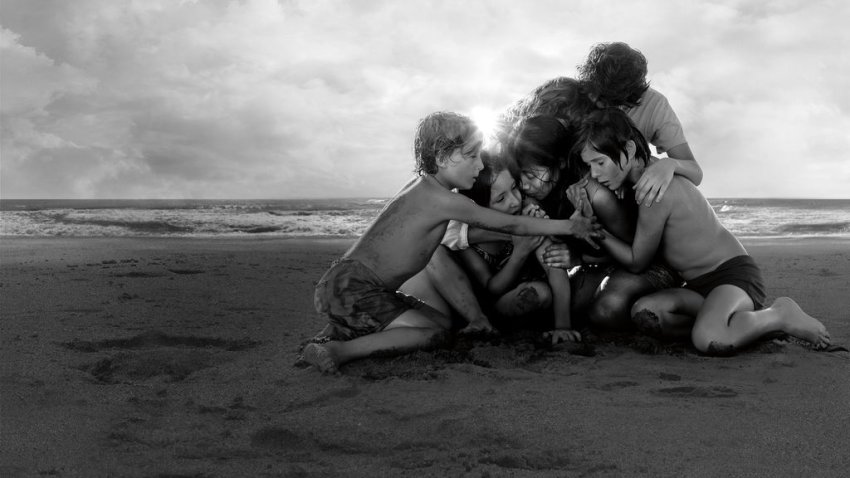
Roma
Written & directed by Alfonso Cuaron
Starring Yalitza Aparicio & Marina de Tavira
In cinemas now
Roma is the latest film by Mexican director Alfonso Cuaron, who came to international prominence with his 2001 film Y Tu Mama Tambien.
This allowed him to break into the world of bigger budget, English-language films, directing Children of Men (2006) and Gravity (2013) which won seven Academy Awards including best director.
He was also involved in the production of the documentary short The Shock Doctrine (2007), based on Naomi Klein’s book and directed by his son Jonas Cuaron.
With Roma, he returns to his native Mexico. It is probably only thanks to his previous Hollywood success that a somewhat arthouse, black and white, foreign-language film that would seem more at home in Cannes has received 10 Academy Award nominations.
The film is set in the early 1970s in the Mexico City district of Roma and follows the life of a family over the course of a year. It is mostly centred on the character of Cleo (Yalitza Aparicio), one of the family’s two domestic workers.
The film has a definite narrative, but it is secondary to presenting the texture of the time and place, and of the family’s life. Not foregrounded but plainly present in this texture are divisions of class and race, and political violence.
The film is semi-autobiographical, based on Cuaron’s memories of growing up in 1970s Mexico City. The dedication at the end is to Libo — his childhood nanny on whom Cleo is based.
Cuaron’s family were relatively privileged and some quite right wing. His uncle, however, was a communist. From him, Cuaron learnt about politics and history.
One of the key scenes in the film is drawn from a memory of a photo his uncle had of a terrified young man running down a street, looking over his shoulder as he is chased by men with bamboo sticks while people look on from the window of a furniture shop.
Although it isn’t spelt out, the scene is based on the 1971 Corpus Christi massacre where nearly 120 demonstrators were killed by US-trained paramilitary thugs. This had followed the more notorious Tlatelolco massacre where an estimated 400 were killed in the lead up to the 1968 Mexico City Olympic Games.
Cleo is treated, in many respects, as part of the family. Her relationship with the children is probably closer and more affectionate than that of the mother (Marina de Tavira). When she falls pregnant, the family take her to hospital and shopping for children’s’ furniture.
At the same time, her situation is clearly very different to that of the family. The family are urban, educated and European. She is a poor, indigenous woman from a country village.
With the family she speaks in Spanish. With fellow domestic worker Adela (Nancy Garcia Garcia) she speaks in Mixteco.
In a scene that reflects her closeness to and separateness from the family, the family are sitting together on the lounge watching television having finished their day.
Cleo collects their plates from them while glancing at the television. She then sits down next to one of the children who puts an arm around her. She watches for a few moments before getting up again and taking the dishes out to the kitchen to wash up.
She then puts the children to bed, before going outside the main and rather spacious house to retire to the small room she shares with Adela.
The film concentrates on the personal lives of Cleo and the family. The political events and issues in the film aren’t explained and, while they are in the film, the narrative doesn’t follow them.
This reflects the way that Cuaron experienced these issues — and how many other people experience such issues — growing up amongst them. That is, not obviously but as a part of everyday life. Being a child and growing up in a comfortable, well-to-do environment, the surrounding political violence and exploitation only becomes visible with maturity and reflection.
“It was probably my own guilt about social dynamics, class dynamics, racial dynamics,” Cuaron told Variety. “I was a white, middle-class, Mexican kid living in this bubble.
“I didn’t have an awareness. I [had] what your parents tell you — that you have to be nice to people who are less privileged than you and all of that — but you’re in your childhood universe.”
The deliberate stand-offish treatment of these issues, and likewise the fairly non-melodramatic treatment of the characters’ personal struggles, are especially enhanced by the use of the camera that keeps a fly-on-the-wall distance.
It is generally shot with fairly wide camera angles, long takes and slow tracking shots.
Even during the most dramatic moments, it doesn’t jump to close ups or accelerate the pace of the editing — the camera still follows slowly and at a distance.
This contributes to the unmistakeable beauty of the film. Cuaron was cinematographer and editor, as well as writer and director.
The use of black and white not only gives a sense of the past but also enhances the imagery. The lingering camera captures many spectacular and haunting scenes, sometimes semi-surreal, beginning with the opening credits set against a backdrop of soapy water on a tiled floor.
Overall it makes a remarkable package of beauty, warm memories, racism and exploitation.